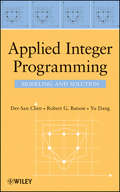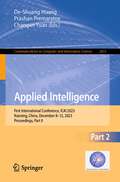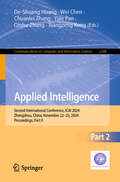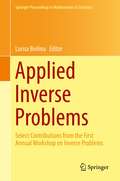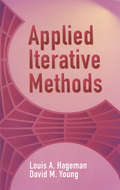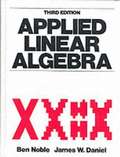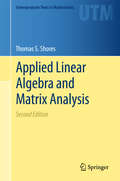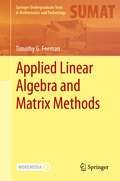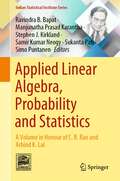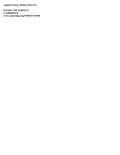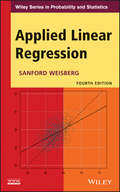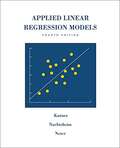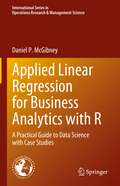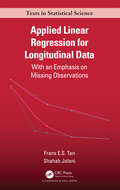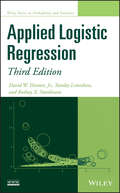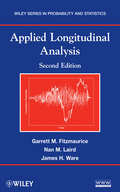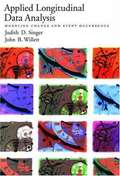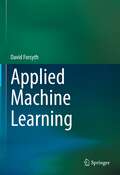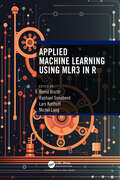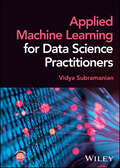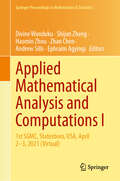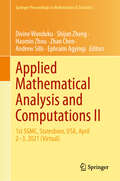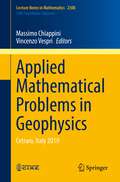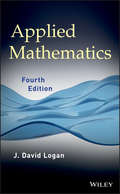- Table View
- List View
Applied Integer Programming
by Der-San Chen Yu Dang Robert G. BatsonAn accessible treatment of the modeling and solution of integer programming problems, featuring modern applications and softwareIn order to fully comprehend the algorithms associated with integer programming, it is important to understand not only how algorithms work, but also why they work. Applied Integer Programming features a unique emphasis on this point, focusing on problem modeling and solution using commercial software. Taking an application-oriented approach, this book addresses the art and science of mathematical modeling related to the mixed integer programming (MIP) framework and discusses the algorithms and associated practices that enable those models to be solved most efficiently.The book begins with coverage of successful applications, systematic modeling procedures, typical model types, transformation of non-MIP models, combinatorial optimization problem models, and automatic preprocessing to obtain a better formulation. Subsequent chapters present algebraic and geometric basic concepts of linear programming theory and network flows needed for understanding integer programming. Finally, the book concludes with classical and modern solution approaches as well as the key components for building an integrated software system capable of solving large-scale integer programming and combinatorial optimization problems.Throughout the book, the authors demonstrate essential concepts through numerous examples and figures. Each new concept or algorithm is accompanied by a numerical example, and, where applicable, graphics are used to draw together diverse problems or approaches into a unified whole. In addition, features of solution approaches found in today's commercial software are identified throughout the book.Thoroughly classroom-tested, Applied Integer Programming is an excellent book for integer programming courses at the upper-undergraduate and graduate levels. It also serves as a well-organized reference for professionals, software developers, and analysts who work in the fields of applied mathematics, computer science, operations research, management science, and engineering and use integer-programming techniques to model and solve real-world optimization problems.
Applied Intelligence: First International Conference, ICAI 2023, Nanning, China, December 8–12, 2023, Proceedings, Part II (Communications in Computer and Information Science #2015)
by Prashan Premaratne De-Shuang Huang Changan YuanThis 2-volume set CCIS 2014 and CCIS 2015 constitutes the post-conference proceedings of the First International Conference on Applied Intelligence, ICAI 2023, held in Nanning, China, December 8–12, 2023.The 64 full papers presented in this proceedings were carefully selected and reviewed from 228 submissions. The papers cover a wide range on theoretical aspects of biomedical data modeling and mining; computer vision; and deep learning. They were organized in topical sections as follows:Part I: Biomedical data modeling and mining; computer vision; deep learning; Part II: Intelligent control and automation; machine learning; natural language processing and computational linguistics.
Applied Intelligence: Second International Conference, ICAI 2024, Zhengzhou, China, November 22–25, 2024, Proceedings, Part I (Communications in Computer and Information Science #2387)
by Wei Chen De-Shuang Huang Yijie Pan Qinhu Zhang Chuanlei Zhang Xiangzeng KongThis 2-volume set CCIS 2387 + 2388 constitutes the proceedings of the Second International Conference on Applied Intelligence, ICAI 2024, held in Zhengzhou, China, during November 22-25, 2024. The 72 full papers presented in this proceedings were carefully reviewed and selected from 228 submissions. The papers cover a wide range on theoretical aspects of biomedical data modeling and mining; computer vision; and deep learning. They were organized in topical sections as follows: Part I: Biomedical data modeling and mining; information security; pattern recognition; Part II: Image Processing; intelligent data analysis and prediction; machine learning;
Applied Intelligence: Second International Conference, ICAI 2024, Zhengzhou, China, November 22–25, 2024, Proceedings, Part II (Communications in Computer and Information Science #2388)
by Wei Chen De-Shuang Huang Yijie Pan Qinhu Zhang Chuanlei Zhang Xiangzeng KongThis 2-volume set CCIS 2387 + 2388 constitutes the proceedings of the Second International Conference on Applied Intelligence, ICAI 2024, held in Zhengzhou, China, during November 22-25, 2024. The 72 full papers presented in this proceedings were carefully reviewed and selected from 228 submissions. The papers cover a wide range on theoretical aspects of biomedical data modeling and mining; computer vision; and deep learning. They were organized in topical sections as follows: Part I: Biomedical data modeling and mining; information security; pattern recognition; Part II: Image Processing; intelligent data analysis and prediction; machine learning;
Applied Inverse Problems: Select Contributions from the First Annual Workshop on Inverse Problems (Springer Proceedings in Mathematics & Statistics #48)
by Larisa BeilinaThis proceedings volume is based on papers presented at the First Annual Workshop on Inverse Problems which was held in June 2011 at the Department of Mathematics, Chalmers University of Technology. The purpose of the workshop was to present new analytical developments and numerical methods for solutions of inverse problems. State-of-the-art and future challenges in solving inverse problems for a broad range of applications was also discussed. The contributions in this volume are reflective of these themes and will be beneficial to researchers in this area.
Applied Iterative Methods (Dover Books on Mathematics)
by Louis A. Hageman David M. YoungThis graduate-level text examines the practical use of iterative methods in solving large, sparse systems of linear algebraic equations and in resolving multidimensional boundary-value problems. Assuming minimal mathematical background, it profiles the relative merits of several general iterative procedures. Topics include polynomial acceleration of basic iterative methods, Chebyshev and conjugate gradient acceleration procedures applicable to partitioning the linear system into a "red/black" block form, adaptive computational algorithms for the successive overrelaxation (SOR) method, and computational aspects in the use of iterative algorithms for solving multidimensional problems. 1981 edition. 48 figures. 35 tables.
Applied Linear Algebra
by Ben Noble James W. DanielContains important modern applications such as signal processing and Karmarkar's approach to linear programming. Uses Gauss reduction and 'Gauss-reduced form' as the fundamental theoretical and computational tool. Includes examples and problems using modern software for matrix computations, and describes properties and sources of software for real applied problems. Stresses both the theoretical and practical importance of tools such as the singular-value decomposition and generalized (pseudo) inverses, the QR decomposition, Householder transformations/matrices, and orthogonal projections. Features 1,100 exercises, including optional computer examples and problems.
Applied Linear Algebra and Matrix Analysis (Undergraduate Texts In Mathematics)
by Thomas S. ShoresIn its second edition, this textbook offers a fresh approach to matrix and linear algebra. Its blend of theory, computational exercises, and analytical writing projects is designed to highlight the interplay between these aspects of an application. This approach places special emphasis on linear algebra as an experimental science that provides tools for solving concrete problems.<P><P> The second edition’s revised text discusses applications of linear algebra like graph theory and network modeling methods used in Google’s PageRank algorithm. Other new materials include modeling examples of diffusive processes, linear programming, image processing, digital signal processing, and Fourier analysis. These topics are woven into the core material of Gaussian elimination and other matrix operations; eigenvalues, eigenvectors, and discrete dynamical systems; and the geometrical aspects of vector spaces.<P> Intended for a one-semester undergraduate course without a strict calculus prerequisite, Applied Linear Algebra and Matrix Analysis augments the key elements of linear algebra with a wide choice of optional sections. With the book’s selection of applications and platform-independent assignments, instructors can tailor the curriculum to suit specific interests and ensure students across various disciplines are equipped with the powerful tools of linear algebra.
Applied Linear Algebra and Matrix Methods (Springer Undergraduate Texts in Mathematics and Technology)
by Timothy G. FeemanThis textbook is designed for a first course in linear algebra for undergraduate students from a wide range of quantitative and data driven fields. By focusing on applications and implementation, students will be prepared to go on to apply the power of linear algebra in their own discipline. With an ever-increasing need to understand and solve real problems, this text aims to provide a growing and diverse group of students with an applied linear algebra toolkit they can use to successfully grapple with the complex world and the challenging problems that lie ahead. Applications such as least squares problems, information retrieval, linear regression, Markov processes, finding connections in networks, and more, are introduced on a small scale as early as possible and then explored in more generality as projects. Additionally, the book draws on the geometry of vectors and matrices as the basis for the mathematics, with the concept of orthogonality taking center stage. Important matrix factorizations as well as the concepts of eigenvalues and eigenvectors emerge organically from the interplay between matrix computations and geometry.The R files are extra and freely available. They include basic code and templates for many of the in-text examples, most of the projects, and solutions to selected exercises. As much as possible, data sets and matrix entries are included in the files, thus reducing the amount of manual data entry required.
Applied Linear Algebra, Probability and Statistics: A Volume in Honour of C. R. Rao and Arbind K. Lal (Indian Statistical Institute Series)
by Ravindra B. Bapat Simo Puntanen Manjunatha Prasad Karantha Stephen J. Kirkland Samir Kumar Neogy Sukanta PatiThis book focuses on research in linear algebra, statistics, matrices, graphs and their applications. Many chapters in the book feature new findings due to applications of matrix and graph methods. The book also discusses rediscoveries of the subject by using new methods. Dedicated to Prof. Calyampudi Radhakrishna Rao (C.R. Rao) who has completed 100 years of legendary life and continues to inspire us all and Prof. Arbind K. Lal who has sadly departed us too early, it has contributions from collaborators, students, colleagues and admirers of Professors Rao and Lal. With many chapters on generalized inverses, matrix analysis, matrices and graphs, applied probability and statistics, and the history of ancient mathematics, this book offers a diverse array of mathematical results, techniques and applications. The book promises to be especially rewarding for readers with an interest in the focus areas of applied linear algebra, probability and statistics.
Applied Linear Models with SAS
by Daniel ZeltermanThis textbook for a second course in basic statistics for undergraduates or first-year graduate students introduces linear regression models and describes other linear models including Poisson regression, logistic regression, proportional hazards regression, and nonparametric regression. Numerous examples drawn from the news and current events with an emphasis on health issues illustrate these concepts. Assuming only a pre-calculus background, the author keeps equations to a minimum and demonstrates all computations using SAS. Most of the programs and output are displayed in a self-contained way, with an emphasis on the interpretation of the output in terms of how it relates to the motivating example. Plenty of exercises conclude every chapter. All of the datasets and SAS programs are available from the book's website, along with other ancillary material.
Applied Linear Regression
by Sanford WeisbergPraise for the Third Edition"...this is an excellent book which could easily be used as a course text..."--International Statistical InstituteThe Fourth Edition of Applied Linear Regression provides a thorough update of the basic theory and methodology of linear regression modeling. Demonstrating the practical applications of linear regression analysis techniques, the Fourth Edition uses interesting, real-world exercises and examples.Stressing central concepts such as model building, understanding parameters, assessing fit and reliability, and drawing conclusions, the new edition illustrates how to develop estimation, confidence, and testing procedures primarily through the use of least squares regression. While maintaining the accessible appeal of each previous edition,Applied Linear Regression, Fourth Edition features:Graphical methods stressed in the initial exploratory phase, analysis phase, and summarization phase of an analysisIn-depth coverage of parameter estimates in both simple and complex models, transformations, and regression diagnosticsNewly added material on topics including testing, ANOVA, and variance assumptionsUpdated methodology, such as bootstrapping, cross-validation binomial and Poisson regression, and modern model selection methodsApplied Linear Regression, Fourth Edition is an excellent textbook for upper-undergraduate and graduate-level students, as well as an appropriate reference guide for practitioners and applied statisticians in engineering, business administration, economics, and the social sciences.
Applied Linear Regression Models
by Michael H. Kutner John Neter Christopher J. NachtsheimKutner, Nachtsheim, Neter, Wasserman, Applied Linear Regression Models, 4/e (ALRM4e) is the long established leading authoritative text and reference on regression (previously Neter was lead author.) For students in most any discipline where statistical analysis or interpretation is used, ALRM has served as the industry standard. The text includes brief introductory and review material, and then proceeds through regression and modeling. All topics are presented in a precise and clear style supported with solved examples, numbered formulae, graphic illustrations, and "Comments" to provide depth and statistical accuracy and precision. Applications used within the text and the hallmark problems, exercises, and projects are drawn from virtually all disciplines and fields providing motivation for students in any discipline. ALRM 4e provides an increased use of computing and graphical analysis throughout, without sacrificing concepts or rigor.
Applied Linear Regression for Business Analytics with R: A Practical Guide to Data Science with Case Studies (International Series in Operations Research & Management Science #337)
by Daniel P. McGibneyApplied Linear Regression for Business Analytics with R introduces regression analysis to business students using the R programming language with a focus on illustrating and solving real-time, topical problems. Specifically, this book presents modern and relevant case studies from the business world, along with clear and concise explanations of the theory, intuition, hands-on examples, and the coding required to employ regression modeling. Each chapter includes the mathematical formulation and details of regression analysis and provides in-depth practical analysis using the R programming language.
Applied Linear Regression for Longitudinal Data: With an Emphasis on Missing Observations (Chapman & Hall/CRC Texts in Statistical Science)
by Frans E.S. Tan Shahab JolaniThis book introduces best practices in longitudinal data analysis at intermediate level, with a minimum number of formulas without sacrificing depths. It meets the need to understand statistical concepts of longitudinal data analysis by visualizing important techniques instead of using abstract mathematical formulas. Different solutions such as multiple imputation are explained conceptually and consequences of missing observations are clarified using visualization techniques. Key features include the following: • Provides datasets and examples online • Gives state-of-the-art methods of dealing with missing observations in a non-technical way with a special focus on sensitivity analysis • Conceptualises the analysis of comparative (experimental and observational) studies It is the ideal companion for researcher and students in epidemiological, health, and social and behavioral sciences working with longitudinal studies without a mathematical background. Frans E.S. Tan is an associate professor (retired) of methodology and statisticsat Maastricht University, The Netherlands. Shahab Jolani is an assistant professor of methodology and statistics atMaastricht University, The Netherlands.
Applied Logistic Regression (Wiley Series in Probability and Statistics #398)
by Stanley Lemeshow David W. Hosmer Jr. Rodney X. SturdivantA new edition of the definitive guide to logistic regression modeling for health science and other applicationsThis thoroughly expanded Third Edition provides an easily accessible introduction to the logistic regression (LR) model and highlights the power of this model by examining the relationship between a dichotomous outcome and a set of covariables.Applied Logistic Regression, Third Edition emphasizes applications in the health sciences and handpicks topics that best suit the use of modern statistical software. The book provides readers with state-of-the-art techniques for building, interpreting, and assessing the performance of LR models. New and updated features include:A chapter on the analysis of correlated outcome dataA wealth of additional material for topics ranging from Bayesian methods to assessing model fitRich data sets from real-world studies that demonstrate each method under discussionDetailed examples and interpretation of the presented results as well as exercises throughoutApplied Logistic Regression, Third Edition is a must-have guide for professionals and researchers who need to model nominal or ordinal scaled outcome variables in public health, medicine, and the social sciences as well as a wide range of other fields and disciplines.
Applied Longitudinal Analysis
by Nan M. Laird Garrett M. Fitzmaurice James H. WareFeatures newly developed topics and applications of the analysis of longitudinal data. Applied Longitudinal Analysis, Second Edition presents modern methods for analyzing data from longitudinal studies and now features the latest state-of-the-art techniques. The book emphasizes practical, rather than theoretical, aspects of methods for the analysis of diverse types of longitudinal data that can be applied across various fields of study, from the health and medical sciences to the social and behavioral sciences.The authors incorporate their extensive academic and research experience along with various updates that have been made in response to reader feedback. The Second Edition features six newly added chapters that explore topics currently evolving in the field, including:Fixed effects and mixed effects models. Marginal models and generalized estimating equations. Approximate methods for generalized linear mixed effects models. Multiple imputation and inverse probability weighted methods. Smoothing methods for longitudinal data. Sample size and power. Each chapter presents methods in the setting of applications to data sets drawn from the health sciences. New problem sets have been added to many chapters, and a related website features sample programs and computer output using SAS, Stata, and R, as well as data sets and supplemental slides to facilitate a complete understanding of the material.With its strong emphasis on multidisciplinary applications and the interpretation of results, Applied Longitudinal Analysis, Second Edition is an excellent book for courses on statistics in the health and medical sciences at the upper-undergraduate and graduate levels. The book also serves as a valuable reference for researchers and professionals in the medical, public health, and pharmaceutical fields as well as those in social and behavioral sciences who would like to learn more about analyzing longitudinal data.
Applied Longitudinal Data Analysis: Modeling Change and Event Occurrence
by Judith D. Singer John B. WillettChange is constant in everyday life. Infants crawl and then walk, children learn to read and write, teenagers mature in myriad ways, the elderly become frail and forgetful. Beyond these natural processes and events, external forces and interventions instigate and disrupt change: test scores may rise after a coaching course, drug abusers may remain abstinent after residential treatment. By charting changes over time and investigating whether and when events occur, researchers reveal the temporal rhythms of our lives. Applied Longitudinal Data Analysis is a much-needed professional book for empirical researchers and graduate students in the behavioral, social, and biomedical sciences. It offers the first accessible in-depth presentation of two of today's most popular statistical methods: multilevel models for individual change and hazard/survival models for event occurrence (in both discrete- and continuous-time). Using clear, concise prose and real data sets from published studies, the authors take you step by step through complete analyses, from simple exploratory displays that reveal underlying patterns through sophisticated specifications of complex statistical models. Applied Longitudinal Data Analysis offers readers a private consultation session with internationally recognized experts and represents a unique contribution to the literature on quantitative empirical methods.
Applied Machine Learning
by David ForsythMachine learning methods are now an important tool for scientists, researchers, engineers and students in a wide range of areas. This book is written for people who want to adopt and use the main tools of machine learning, but aren’t necessarily going to want to be machine learning researchers. Intended for students in final year undergraduate or first year graduate computer science programs in machine learning, this textbook is a machine learning toolkit. Applied Machine Learning covers many topics for people who want to use machine learning processes to get things done, with a strong emphasis on using existing tools and packages, rather than writing one’s own code.A companion to the author's Probability and Statistics for Computer Science, this book picks up where the earlier book left off (but also supplies a summary of probability that the reader can use).Emphasizing the usefulness of standard machinery from applied statistics, this textbook gives an overview of the major applied areas in learning, including coverage of:• classification using standard machinery (naive bayes; nearest neighbor; SVM)• clustering and vector quantization (largely as in PSCS)• PCA (largely as in PSCS)• variants of PCA (NIPALS; latent semantic analysis; canonical correlation analysis)• linear regression (largely as in PSCS)• generalized linear models including logistic regression• model selection with Lasso, elasticnet• robustness and m-estimators• Markov chains and HMM’s (largely as in PSCS)• EM in fairly gory detail; long experience teaching this suggests one detailed example is required, which students hate; but once they’ve been through that, the next one is easy• simple graphical models (in the variational inference section)• classification with neural networks, with a particular emphasis onimage classification• autoencoding with neural networks• structure learning
Applied Machine Learning Using mlr3 in R
by Lars Kotthoff Bernd Bischl Raphael Sonabend Michel Langmlr3 is an award-winning ecosystem of R packages that have been developed to enable state-of-the-art machine learning capabilities in R. Applied Machine Learning Using mlr3 in R gives an overview of flexible and robust machine learning methods, with an emphasis on how to implement them using mlr3 in R. It covers various key topics, including basic machine learning tasks, such as building and evaluating a predictive model; hyperparameter tuning of machine learning approaches to obtain peak performance; building machine learning pipelines that perform complex operations such as pre-processing followed by modelling followed by aggregation of predictions; and extending the mlr3 ecosystem with custom learners, measures, or pipeline components. Features: In-depth coverage of the mlr3 ecosystem for users and developers Explanation and illustration of basic and advanced machine learning concepts Ready to use code samples that can be adapted by the user for their application Convenient and expressive machine learning pipelining enabling advanced modelling Coverage of topics that are often ignored in other machine learning books The book is primarily aimed at researchers, practitioners, and graduate students who use machine learning or who are interested in using it. It can be used as a textbook for an introductory or advanced machine learning class that uses R, as a reference for people who work with machine learning methods, and in industry for exploratory experiments in machine learning.
Applied Machine Learning for Data Science Practitioners
by Vidya SubramanianA single-volume reference on data science techniques for evaluating and solving business problems using Applied Machine Learning (ML). Applied Machine Learning for Data Science Practitioners offers a practical, step-by-step guide to building end-to-end ML solutions for real-world business challenges, empowering data science practitioners to make informed decisions and select the right techniques for any use case. Unlike many data science books that focus on popular algorithms and coding, this book takes a holistic approach. It equips you with the knowledge to evaluate a range of techniques and algorithms. The book balances theoretical concepts with practical examples to illustrate key concepts, derive insights, and demonstrate applications. In addition to code snippets and reviewing output, the book provides guidance on interpreting results. This book is an essential resource if you are looking to elevate your understanding of ML and your technical capabilities, combining theoretical and practical coding examples. A basic understanding of using data to solve business problems, high school-level math and statistics, and basic Python coding skills are assumed. Written by a recognized data science expert, Applied Machine Learning for Data Science Practitioners covers essential topics, including: Data Science Fundamentals that provide you with an overview of core concepts, laying the foundation for understanding ML. Data Preparation covers the process of framing ML problems and preparing data and features for modeling. ML Problem Solving introduces you to a range of ML algorithms, including Regression, Classification, Ranking, Clustering, Patterns, Time Series, and Anomaly Detection. Model Optimization explores frameworks, decision trees, and ensemble methods to enhance performance and guide the selection of the most effective model. ML Ethics addresses ethical considerations, including fairness, accountability, transparency, and ethics. Model Deployment and Monitoring focuses on production deployment, performance monitoring, and adapting to model drift.
Applied Mathematical Analysis and Computations I: 1st SGMC, Statesboro, USA, April 2–3, 2021 (Virtual) (Springer Proceedings in Mathematics & Statistics #471)
by Divine Wanduku Shijun Zheng Haomin Zhou Zhan Chen Andrew Sills Ephraim AgyingiThis volume convenes selected, peer-reviewed research and survey articles that address the modern state-of-the-art in varied areas of applied mathematical analysis. They primarily include presentations as well as invited contributions for the 1st Southern Georgia Mathematics Conference (SGMC) that was virtually held on April 2—3, 2021 at the Georgia Southern University, Statesboro, USA. Papers in this volume incorporate both advanced theory and methods from mathematical analysis, and cover myriad topics like imaging and inverse problems, evolutionary PDEs, symbolic computation, dynamics and data analysis, data science, computational mathematics, and more. This first volume focuses on mathematical analysis theory and applications. These studies and findings contained herein will be of interest to researchers and graduate students working in the fields of mathematical analysis, modeling, data analysis and computation, with applications in many interdisciplinary applied sciences, as in statistics, physics, biology, and medical imaging. They are particularly relevant to those at the forefront of applied mathematical and statistical analysis, as well as data science and other computational science disciplines. In its first edition, the Southern Georgia Mathematics Conference brought together 74 speakers from 70 different institutions, from the USA, Canada, Austria, and Botswana. Attendees included faculty, researchers, experts, graduate and undergraduate students from all over the world.
Applied Mathematical Analysis and Computations II: 1st SGMC, Statesboro, USA, April 2–3, 2021 (Virtual) (Springer Proceedings in Mathematics & Statistics #472)
by Divine Wanduku Shijun Zheng Haomin Zhou Zhan Chen Andrew Sills Ephraim AgyingiThis volume convenes selected, peer-reviewed research and survey articles that address the modern state-of-the-art in varied areas of applied mathematical analysis. They were presented at the 1st Southern Georgia Mathematics Conference (SGMC) that was virtually held on April 2—3, 2021, at Georgia Southern University, Statesboro, USA. Papers in this volume incorporate both advanced theory and methods from mathematical analysis and cover myriad topics such as imaging and inverse problems, evolutionary PDEs, symbolic computation, dynamics and data analysis, data science, computational mathematics, and more. This second volume focuses on modeling, simulation and data analytical studies in the field of computational mathematics. These studies and findings contained herein will be of interest to researchers and graduate students working in the fields of mathematical analysis, modeling, data analysis, and computation, with applications in many interdisciplinary applied sciences, including statistics, physics, biology, and medical imaging. They are particularly relevant to those at the forefront of applied mathematical and statistical analysis, as well as data science and other computational science disciplines. In its first edition, the Southern Georgia Mathematics Conference brought together 74 speakers from 70 different institutions, including the USA, Canada, Austria, and Botswana. Attendees included faculty, researchers, experts, graduate, and undergraduate students from all over the world.
Applied Mathematical Problems in Geophysics: Cetraro, Italy 2019 (Lecture Notes in Mathematics #2308)
by Vincenzo Vespri Massimo ChiappiniThis CIME Series book provides mathematical and simulation tools to help resolve environmental hazard and security-related issues.The contributions reflect five major topics identified by the SIES (Strategic Initiatives for the Environment and Security) as having significant societal impact: optimal control in waste management, in particular the degradation of organic waste by an aerobic biomass, by means of a mathematical model; recent developments in the mathematical analysis of subwave resonators; conservation laws in continuum mechanics, including an elaboration on the notion of weak solutions and issues related to entropy criteria; the applications of variational methods to 1-dimensional boundary value problems, in particular to light ray-tracing in ionospheric physics; and the mathematical modelling of potential electromagnetic co-seismic events associated to large earthquakes.This material will provide a sound foundation for those who intend to approach similar problems from a multidisciplinary perspective.
Applied Mathematics
by J. David LoganApplied Mathematics, Fourth Edition is a thoroughly updated and revised edition on the applications of modeling and analyzing natural, social, and technological processes. The book covers a wide range of key topics in mathematical methods and modeling and highlights the connections between mathematics and the applied and natural sciences. The Fourth Edition covers both standard and modern topics, including scaling and dimensional analysis; regular and singular perturbation; calculus of variations; Green's functions and integral equations; nonlinear wave propagation; and stability and bifurcation. The book provides extended coverage of mathematical biology, including biochemical kinetics, epidemiology, viral dynamics, and parasitic disease. In addition, the new edition features:Expanded coverage on orthogonality, boundary value problems, and distributions, all of which are motivated by solvability and eigenvalue problems in elementary linear algebra. Additional MATLAB® applications for computer algebra system calculations. Over 300 exercises and 100 illustrations that demonstrate important concepts. New examples of dimensional analysis and scaling along with new tables of dimensions and units for easy reference. Review material, theory, and examples of ordinary differential equations. New material on applications to quantum mechanics, chemical kinetics, and modeling diseases and viruses. Written at an accessible level for readers in a wide range of scientific fields, Applied Mathematics, Fourth Edition is an ideal text for introducing modern and advanced techniques of applied mathematics to upper-undergraduate and graduate-level students in mathematics, science, and engineering. The book is also a valuable reference for engineers and scientists in government and industry.
